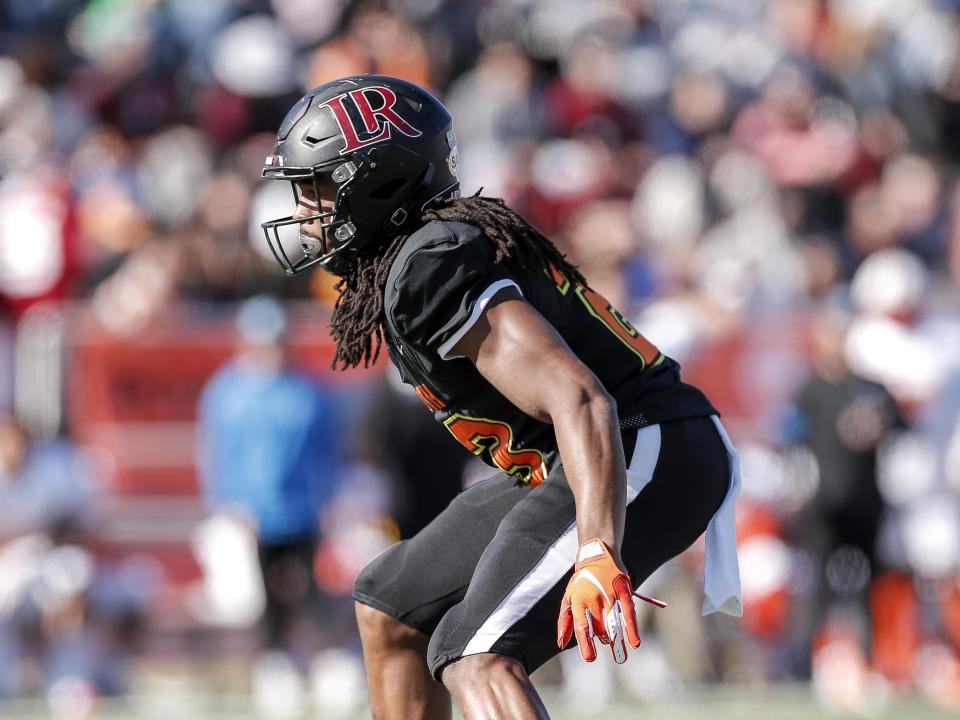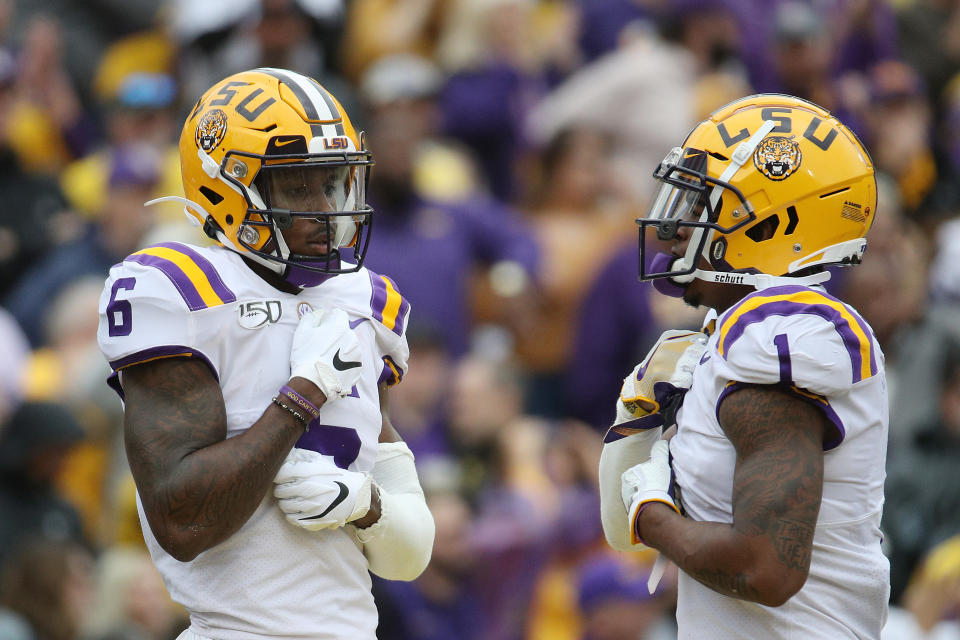NFL draft: Why spring grades could carry extra weight for the 2021 class
Each May, the NFL’s two major scouting services, National Football Scouting and BLESTO, set their initial grades for prospects expected to be eligible for the following year’s draft. The numbers are merely a launching point, and by the time the actual draft rolls around, those figures typically don’t carry a lot of weight.
In a normal year, those grades merely allow for NFL teams who subscribe to their services to map out the early scouting process for the college football season, helping teams prioritize where to send their area scouts and other talent evaluators.
It’s important not only for identifying the highest-graded individual prospects, but also for determining which teams have the most prospects in a given year.
For instance, LSU had only three players drafted in 2019, but most NFL clubs knew the Tigers were loaded with 2020 prospects. That made Baton Rouge a popular scouting stop last year; LSU ended up with a record-tying 14 players drafted this past spring.
This year’s spring scouting process has been different — and the potential impact on the 2021 NFL draft could be significant. Whether or not we have a college football season.

Lack of ‘Junior Day’ workouts cloud picture
The COVID-19 pandemic shut down most spring football activities on college campuses, so there were no “Junior Day” workouts to help scouting services perform their duties. These pro day-style workouts provide a template they can use to formulate a picture on prospects.
This excludes two categories of prospects. The first would be the group of players who are so transcendent in their final seasons, they vault from afterthought to prime prospect. There’s no better example from this past year than LSU QB Joe Burrow, the No. 1 overall pick in 2020. (We recently tried to identify a few players who could experience a Burrow-like rise with a big 2020 season.)
The other category would be the small-school prospects who might otherwise fall below the radar.
Last year, a little-known prospect from D-II Lenoir-Rhyne named Kyle Dugger measured well for a safety, and he ran and jumped exceptionally well at the school’s “Junior Day.” It helped make Dugger a hot name on the scouting circuit, with all 32 teams visiting a school — one that hadn’t had a prospect drafted into the NFL since 2000 — they might normally pass by.
Despite playing only seven games last season, Dugger was invited to the Senior Bowl and scouting combine. He was the 37th overall pick this spring, and the New England Patriots’ top pick this year.
Will there be a Dugger-esque prospect who cracks the top 50 picks in 2021? That’s hard to say.
We’ve obtained a copy of both services’ grades for this spring, and while there are some small-school prospects with respectable grades — such as Northern Iowa offensive tackle Spencer Brown and Illinois State strong safety Christian Uphoff — it remains to be seen if some lesser-known NFL talents will be unearthed prior to the start of the college football season.
And that brings us to ...
How an interrupted college football season affects scouting
There’s still pessimism in coaching and administrative circles on whether we’ll have a college football season — or at least a complete season.
Some larger schools or conferences might be prepared to stage a mostly uninterrupted year; other smaller schools could be severely hindered because of a number of factors including money and resources to properly keep their athletes, coaches and staff safe.
If the season were to be cut short significantly, it likely would place a higher value on the scouting services’ initial grades, especially for prospects who are not as readily able to improve their stocks with a complete 2020 performance.
Last year’s initial grades are a good example of how much can change over nine months.
NFS issued eight first-round preseason grades last spring — Oregon QB Justin Herbert, Auburn DT Derrick Brown, Alabama DT Raekwon Davis, LSU CB Kristian Fulton, South Carolina DT Javon Kinlaw, Washington OT Trey Adams, Notre Dame EDGE Julian Okwara and Vanderbilt TE Jared Pinkney.
Of those, only three — Herbert, Brown and Kinlaw — ended up as first-rounders. Davis and Fulton fell to the second round. Okwara landed in Round 3 after suffering a broken leg midseason. Adams, predominantly for medical concerns, went undrafted, as did Pinkney following a disappointing final season.
Fortunately, most NFL teams got a head start on evaluating the 2021 class this spring. With the coronavirus cutting down on all travel after mid-March, it allowed scouts to launch into next year’s early evaluations, which could allow them to make up for some of the lost data, even if game tape remains the preferred method of painting a complete scouting profile.
Who the services outline as top-rated prospects for 2021
We have a good idea who the top 2021 prospects are now. But who do the scouting services have as their top-rated players?
NFS, which helps run the NFL scouting combine, evaluates prospects who are rising seniors — no underclassmen at this time. So they don’t have a grade on highly touted QB prospects such as Clemson’s Trevor Lawrence or Ohio State’s Justin Fields.

Six seniors earned the equivalent of a first-round grade: Tennessee OG Trey Smith, Wake Forest EDGE Carlos Basham, Northwestern OT Rashawn Slater, Michigan WR Nico Collins, Alabama WR DeVonta Smith and Ohio State LB Baron Browning. Two others, Clemson RB Travis Etienne and Ohio State LB Pete Werner, check in just below them in the high second-round range.
BLESTO, which gives initial grades to some notable underclassmen, lists eight first-round talents. They are: Lawrence, LSU WR Ja'Marr Chase, Oregon OT Penei Sewell, Alabama CB Patrick Surtain II, Fields, Miami EDGE Gregory Rousseau, Tennessee’s Smith and Alabama’s Smith.
Five others — Etienne, Alabama WR Jaylen Waddle, Clemson WR Justyn Ross, LSU WR Terrance Marshall and Alabama OT Alex Leatherwood — initially came in just below the first-round cutoff. (Ross will miss the season with a serious neck injury. His grade was issued prior to the announcement that he’d have surgery in early June to address a “congenital fusion” in his neck and spine.)
Like with the 2020 spring grades, the 2021 crop must be taken with a grain of salt. Some of these prospects will end up as first-rounders; others, like Adams and Pinkney, could go undrafted. That’s the nature of the highly volatile draft process.
Of course, a lot of that volatility is contingent on a college season being played. If not, or if the season is significantly interrupted, it’s possible that next year’s draft could more closely reflect this year’s earlier evaluations. And that could lead to more draft chaos than normal next April.
More from Yahoo Sports:

 Yahoo Finance
Yahoo Finance 